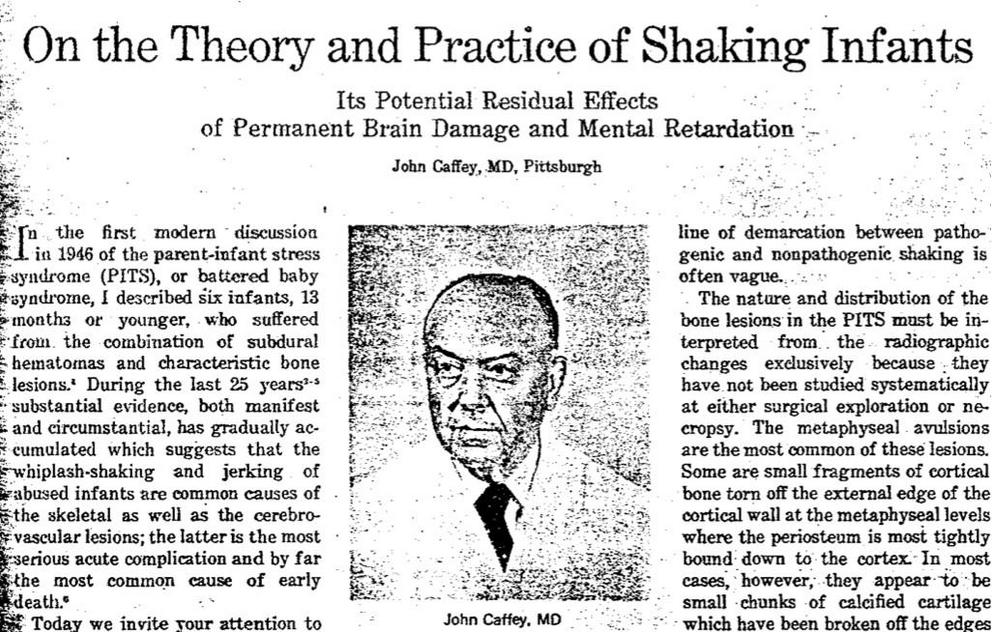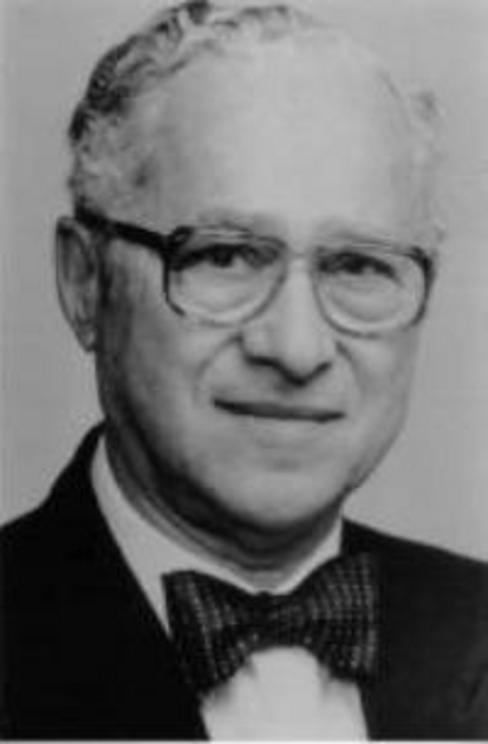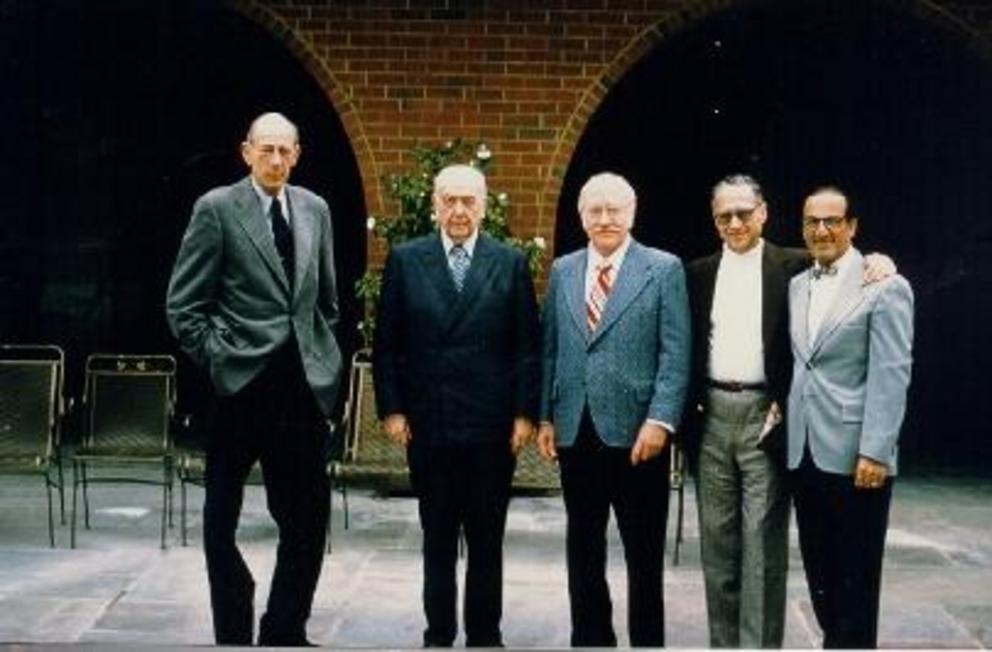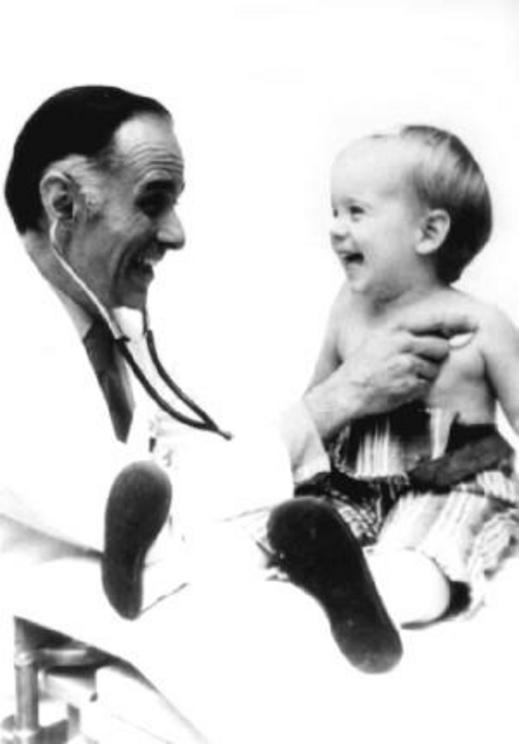History of shaken baby theories exposed: how an elite group of pediatric radiologists started medical kidnapping in the 1940s
“The bones tell the story,” or so the saying goes. But do they tell the full story?
The discovery of the x-ray in 1895 gave rise to a group of doctors who claimed to be able to read the x-rays and find the subtle signs of child abuse that everybody else missed.

It took decades for their rhetoric to be accepted by the public, but when it was finally embraced, it was not long after that The Child Abuse Prevention and Treatment Act of 1974 (CAPTA) was passed by a bipartisan Congress, establishing what we now know as Child Protective Services.
Most historians trace the modern era of Child Welfare to the landmark paper, “The Battered-Child Syndrome” by Dr. C. Henry Kempe and his colleagues, published in 1962.
The paper forms the theoretical framework upon which assumptions by Child Abuse Pediatricians of today are based, up to and including language to circumvent any alternative explanations that parents and other doctors may present.
No matter how much solid medical and scientific research goes into rebutting the allegation that the child was abused, the foregone conclusion by Child Abuse Pediatricians is that it is incorrect.
Dr. John Caffey Established His Breed of Doctors as “The Experts” in Child Abuse – in the 1940s
The history of the paper, and this line of thinking, owes its roots to a man named Dr. John Patrick Caffey who was born in Utah in 1895, the year that Wilhelm Conrad Roentgen accidentally discovered the x-ray, which was originally known as the “roentgen ray.”
After training in internal medicine and pediatrics, he practiced at Babies Hospital in New York as a pediatrician.

Dr. Caffey wrote an influential paper on Shaken Baby Syndrome in 1972. Photo source.
Meanwhile, the field of radiology, the medical specialty of using imaging such as x-rays in the practice of medicine, was in its infancy. There was only one full-time pediatric radiologist in the entire United States in the early 1920s.
As a pediatrician, Dr. Caffey attended occasional radiology conferences, but he became frustrated after attending one such conference, which was taught by a pathologist, not a radiologist.
His comment that it was “another hour wasted” was overheard by Babies Hospital’s chief of pediatrics, who asked him if he thought he could do better. He reportedly answered that he “could hardly do worse.”
As a result, he was put in charge of the hospital’s radiology department in 1929. According to the Society for Pediatric Radiology website:
- He began to realize that the field was wide open for a physician of scholarly bent and pediatric background, and he seized his opportunity. He rapidly taught himself the range of normal appearances and the plain-film manifestations of children’s diseases. [Emphasis added.]
He published the first edition of the Pediatric X-Ray Diagnosis textbook in 1945. He defined what was normal.
The next year he published an article in the American Journal of Roentgenology that examined the case studies of 6 infants admitted to his hospital with subdural hematoma. X-rays showed that the babies also had multiple long bone fractures.
Subdural hematoma (brain bleeding) is one of the “triad” – the 3 symptoms upon which doctors assume a baby has been shaken. Broken bones in babies, even babies with documented conditions of bone fragility, are assumed to be child abuse.
Often broken bones and shaken baby symptoms are seen in the same child.
- With this article, Caffey invited radiologists and paediatricians to be more aware of the possibility that violence was, albeit occasionally, purposefully inflicted upon children.
- Caffey established himself, and the discipline of paediatric radiology, as radical, innovative and unafraid to draw what were, for this period, bold conclusions about child maltreatment.
- Authority in diagnosing the physical mistreatment of children by adults was thus concentrated within the professions of paediatrics and radiology.
Building on Caffey’s early work, these professions consolidated their status as ‘experts’ in managing child battering in both Britain and America over the following 20 years. (Source.)
Thus, Caffey’s paper formed the root of declaring that pediatric radiologists were THE experts in child abuse, long before Dr. Kempe’s 1962 paper and the board certification of Child Abuse Pediatricians which began in 2010.
Caffey’s Junior Assistant Discovers “Unrecognized Skeletal Trauma”
Dr. Frederick Silverman trained at Yale University as a pediatrician. From 1945 to 1947, he trained under Dr. John Caffey at Babies Hospital in New York – the same time period during which Caffey published his paper and book. He became Caffey’s junior assistant.

Dr. Fred Silverman – Photo Source.
From there, Silverman became the Director of the Division of Roentgenolgy at Cincinnati Children’s Hospital in 1947.
He published a paper in 1953 entitled, “The Roentgen Manifestations of Unrecognized Skeletal Trauma in Infants,” in the American Journal of Roentgenology. He noted classic metaphyseal lesions in 3 babies with injuries similar to those in Caffey’s study.
- Silverman concluded that the bone fractures were clearly the result of several traumatic injuries.
- Consequently, he urged physicians to gain accurate patient histories, emphasising that parents may ‘permit trauma and be unaware of it, may recognize trauma but forget or be reluctant to admit it, or may deliberately injure the child and deny it.’ (Source.)
Caffey later joined Silverman to work with him at Cincinnati Children’s Hospital.
Dr. Silverman collaborated as one of the contributing authors of Dr. C. Henry Kempe’s paper, “The Battered-Child Syndrome” in 1962.
Silverman moved to Stanford University Medical Center in California in 1976 where he served as professor emeritus of radiology and practiced at Lucile Salter Packard Children’s Hospital for 25 years.
Dr. Edward Neuhauser
Dr. Edward Neuhauser was born in 1908 and trained in orthopedics. He became “disenchanted” with that field and considered other options including tugboat captain before deciding to enter radiology. According to Radiology:
In 1941, without completing his residency, Dr. Neuhauser became director of radiology at Children’s Hospital, Boston. (Source.)
He became a prolific writer of medical articles and a charismatic teacher of medical students. In 1949, he “established the world’s first regular pediatric radiology fellowship.” (Source.)
Interestingly, he won the Jurzykowski Award in Medical Science for “work in the diagnosis of Wilm’s tumor.” (Source.)
Wilms tumor is the diagnosis that was given, before any biopsy or lab testing was done, to little Grace Beabout, a previous story we covered on MedicalKidnap.com. See:
Exclusive Group of Pediatric Radiologists Is Formed
As the field of pediatric radiology continued to grow, concerns were growing in the general public over the risks of radiation from x-rays, as nuclear weapons were being tested above ground in places like Nevada and the Soviet Union.
There were talks among Caffey and his colleagues about how these doctors would work with the American Academy of Pediatrics and what path they would take.
In what members later referred to as a “jam session,” a group of doctors got together for a day of discussions on April 21, 1958, the day before the opening of the annual meeting of the American Roentgen Ray Society in Washington, DC.
Only a select group of American and Canadian doctors, mostly pediatric radiologists, were invited to the event.
According to the Society for Pediatric Radiology website:
- Though it would have no official connection with the pediatric session, the American Roentgen Ray Society would provide viewboxes, a lantern slide projector, and a blackboard. The meeting would not be publicized to the general membership of the American Roentgen Ray Society.
There were only 9 people present at the exclusive meeting, which was conducted without a printed agenda.
The Society of Pediatric Radiology was established that day, and they met again on September 29 of the same year.
This time there were 33 physicians in attendance, “including 11 who later became president of the society.”
Dr. Neuhauser became the first president, elected by attendees:
- …perhaps because more than half of the charter members had spent some time in Boston under his pedagogical spell.
- Dr. Silverman was named president-elect, not only because of his outstanding qualifications and his close ties to Dr. Caffey (who was not present), but also because he practiced in Cincinnati, the site of the next meeting of the American Roentgen Ray Society.
Rules were established over the next year, including a provision that membership would be limited to:
- …individuals with a primary interest in pediatric radiology and should be limited to 100.
Part or all of the meeting should be closed to everyone but members and contributing guests.
There is no mention of who these “contributing guests” were, what their agenda was, or what they contributed.

Drs. Neuhauser, Caffey, Holt, Silverman, and Taybi at the 1975 meeting of the Society for Pediatric Radiology in Atlanta, Georgia. Source.
Drs. Caffey, Silverman, and Neuhauser each remained involved with the society over the years.
Society Gives Rise to “The Battered-Child Syndrome” Landmark Paper
It was not long after the formation of the Society for Pediatric Radiology in 1958 that Dr. C. Henry Kempe published the previously mentioned paper, “The Battered-Child Syndrome” in 1962.
Dr. Kempe was born Karl Heinz Kempe in what is now Poland on April 6, 1922. He was a Jewish boy born in what was then Germany shortly before the rise of Adolf Hitler and the Nazis. He came to the United States in 1939 at the age of 17 after the war broke out. The Holocaust had already begun.
Before he fled the horrors happening in his homeland, a doctor had taken him under his wing and inspired him to learn medicine. Kempe was accepted into medical school at the University of California, where he studied pediatrics.
In 1948, he became an assistant in pediatrics at Yale.
After his 1962 paper which he wrote with other doctors including Dr. Silverman, he collaborated with Dr. Ray E. Helfer on a book entitled, The Battered Child. He went on to found the National Center for the Prevention and Treatment of Child Abuse and Neglect.
Dr. Helfer considered Dr. Kempe to be his mentor. The Ray E. Helfer Society, an elite group of Child Abuse Pediatricians, was later founded in 1999.

Dr. Ray E. Helfer, founder of the elite Helfer Society of Child Abuse Pediatricians, was mentored by Dr. Kempe. Source.
X-Rays Have Never Told the Whole Picture
These doctors, papers, and the societies that formed around them served to establish pediatric radiologists as the “experts” on child abuse, and x-rays as the primary tool to diagnose abuse, especially when no one else was clever enough to recognize that the child had been abused.
It was all very appealing to doctors, social workers, and attorneys who wanted a definitive magic bullet to identify child abusers. By writing papers that decreed the expertise of radiologists as the proper identifiers of abuse, dissent and opposition were effectively shut down.
The campaign to discredit doctors who disagreed with their interpretation of the data was begun many decades before the Helfer Society began their recent media educational campaign described in our previous article here.
The arguments that parents falsely accused of child abuse face in today’s courtrooms began before their own parents were born.
These arguments have always been challenged by doctors, researchers, scientists, and others who understood from the beginning that x-rays and other diagnostic imaging tools are just that – tools.
They are not adequate to “provide an objective measure of child abuse, but rather must be used merely as one indicator alongside” other evidence. (Source.)
It Goes Back to Funding and Power
As various child abuse societies were established as a result of the efforts of early pediatric radiologists, the mindset of the public and legislators began to change:
- The most significant outcome of these international discussions was not in changing the specific construction of the battered child syndrome, but in enabling a small and disparate group of transfer agents to mutually reassure one another of the fundamental necessity for further research into child battering. (Source.)
Radiologists rose up to be established as the experts able to diagnose child abuse, despite abundant research by other medical professionals which rebuts their conclusions.
Jennifer Crane documents what she calls the “invention” of the battered child syndrome:
- Kempe initially ‘discovered’ this condition and positioned radiologists as the primary diagnostic agent.
She says that:
- …radiologists were particularly successful in negotiating themselves a key role in the identification of child battering….
- In Britain, the publication of ‘The Battered Child Syndrome’ saw radiologists seek to direct funding and resources to their increasingly expensive profession. (Source.)
Pediatric radiologists were the original “Child Abuse Pediatricians” who cleverly positioned themselves in such a way as to assure the continuation of the demand for their services, as well as to secure a never-ending flow of donations from non-profits as well as federal dollars for their continued research into conditions that, often, they made up, to the detriment of innocent families in the United States and around the world.
For full references please use source link below.

